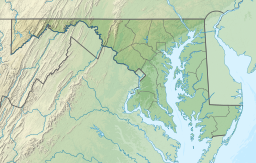Lake Artemesia is an artificial lake in Prince George's County, Maryland, located within the Lake Artemesia Natural Area in College Park and Berwyn Heights. The lake covers an area of 38 acres (150,000 m2), and the surrounding natural area is administered by Maryland-National Capital Park and Planning Commission and includes aquatic gardens, fishing piers, and hiker-biker trails.
| Lake Artemesia | |
|---|---|
 View of the gazebo | |
| Location | College Park, Prince George's County, Maryland, United States |
| Coordinates | 38°59′12″N 76°55′20″W / 38.98667°N 76.92222°W |
| Basin countries | United States |
| Surface area | 38 acres (150,000 m2) |
| Surface elevation | 43 ft (13 m)[1] |
The lake, located between Indian Creek and Paint Branch, was constructed during the late-1980s completion of the Washington Metro's Green Line, which runs alongside the lake. Sand and gravel were excavated from the site of a smaller lake and the surrounding area to construct the rail beds and parking lots for the College Park–University of Maryland and Greenbelt stations.[2] Metro saved $10 million by sourcing the material locally and in return spent $8 million constructing the lake and natural area to repair the excavation damage. During the construction phase, signs identified the site as "Lake Metro."
The park is named for Artemesia N. Drefs, who donated ten lots to the county for preservation as open space in 1972.[3] The smaller lake that existed on the site, which was created in the mid-1800s when stone was quarried from the area for use on the B&O Railroad's Washington Branch line,[4] was already named Lake Artemesia after Artemesia's mother and grandmother, who shared the same name. Drefs's father, Arthur, surveyed the land for his Lakeland development in the 1890s; according to Drefs, the pre-existing lake was originally used to raise goldfish, but was later stocked with bass.[5][6]
The 1.35 mile hiker-biker trail around the lake is part of the Anacostia Tributary Trail System and East Coast Greenway.
The site of Lake Artemesia Park was once home to about one third of the Lakeland community,[7] an African-American community which became part of College Park, Maryland in 1945.[8]
References
edit- ^ U.S. Geological Survey Geographic Names Information System: Lake Artemesia
- ^ Historical Marker Project. "Origins of Lake Artemesia." Accessed 2019-07-30.
- ^ Knuteson, John (2021). "Artemesia Drefs". Missouri Remembers: Artists in Missouri through 1951. Kansas City: The Kansas City Art Institute and The Nelson-Atkins Museum of Art.
- ^ Gross, Maxine (2022-07-15). "Lake Artemesia: My Childhood Lake". College Park Here & Now. Retrieved 2023-01-29.
- ^ Prince George's County Department of Parks and Recreation, Riverdale, MD. "Lake Artemesia." Archived 2013-03-25 at the Wayback Machine Accessed 2009-12-22.
- ^ Kelly, John (2017-12-02). "Perspective | Breeding ponds in College Park, Md., once kept the U.S. awash in goldfish". Washington Post. ISSN 0190-8286. Retrieved 2017-12-09.
- ^ "About The Mural, "A Path Forward"". Lakeland Community Heritage Project. 2018-08-27. Retrieved 2021-02-19.
- ^ EHT Traceries (2007). "Lakeland" (PDF). Maryland National Capitol Parks and Planning Commission. Retrieved February 19, 2021.
External links
edit- Artemesia webpage - Prince George's County Department of Parks and Recreation

